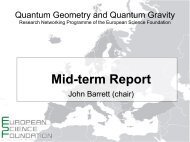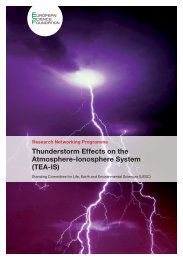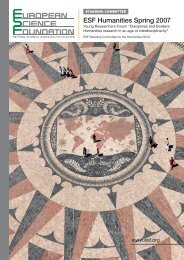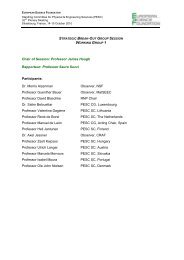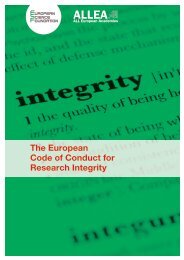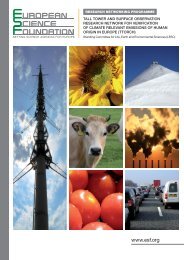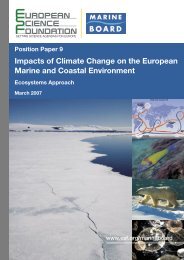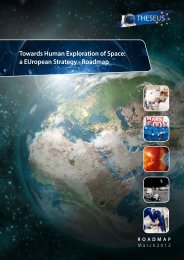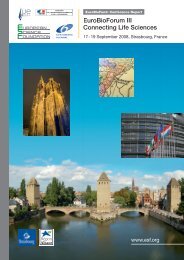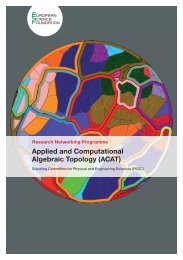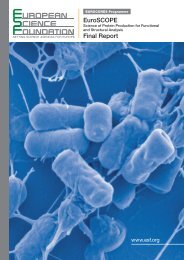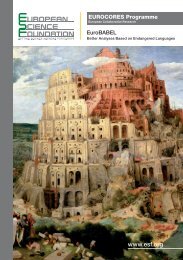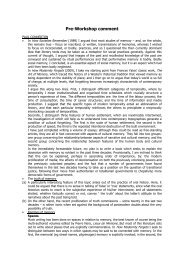Nanomedicine - European Science Foundation
Nanomedicine - European Science Foundation
Nanomedicine - European Science Foundation
You also want an ePaper? Increase the reach of your titles
YUMPU automatically turns print PDFs into web optimized ePapers that Google loves.
6<br />
Foreword<br />
Recent years have witnessed an unprecedented growth in research in the area<br />
of nanoscience. There is increasing optimism that nanotechnology applied<br />
to medicine will bring significant advances in the diagnosis and treatment<br />
of disease. However, many challenges must be overcome if the application of<br />
<strong>Nanomedicine</strong> is to realise the improved understanding of the patho-physiological<br />
basis of disease, bring more sophisticated diagnostic opportunities and yield<br />
more effective therapies. Both the optimism and the challenges have prompted<br />
governmental science and funding organisations to undertake strategic reviews<br />
of the current status of the field 1 , their primary objectives being to assess potential<br />
opportunities for better healthcare as well as the risk-benefit of these new<br />
technologies, and to determine priorities for future funding.<br />
In early 2003, the <strong>European</strong> <strong>Science</strong> <strong>Foundation</strong> launched its Scientific Forward<br />
Look on <strong>Nanomedicine</strong>. I am pleased to see the successful conclusion of this<br />
foresight study, which has been the first such exercise focused on medical<br />
applications of nanoscience and nanotechnology. The Forward Look involved<br />
leading <strong>European</strong> experts and led to a definition of the current status of the field<br />
and debates on strategic policy issues. The recently published Policy Briefing<br />
summarised the recommendations made 2 .<br />
Here the discussions and recommendations are presented in full. Implementation<br />
of these recommendations should ensure continuing <strong>European</strong> leading-edge<br />
research and development in the field of <strong>Nanomedicine</strong>, resulting in reduced<br />
healthcare costs and the rapid realisation of medical benefits for all <strong>European</strong><br />
citizens. ESF will commit itself to taking the initiative and facilitating the relevant<br />
bodies, including ESF Member Organisations and the <strong>European</strong> Commission,<br />
for actions based on these recommendations.<br />
Bertil Andersson<br />
ESF Chief Executive<br />
1. Commission of the <strong>European</strong> Communities Communication: (2004) Towards a <strong>European</strong> Strategy<br />
for Nanotechnology, EU, DG Research, Brussels, (www.cordis.lu/nanotechnology).<br />
ftp://ftp.cordis.lu/pub/era/docs/3_nanomedicinetp_en.pdf<br />
NIH Roadmap: <strong>Nanomedicine</strong> (2004), NIH, USA (http://nihroadmap.nih.gov)<br />
(http://www.capconcorp.com/roadmap04)<br />
UK Royal Society and Royal Academy of Engineering (2004) Report on Nanoscience<br />
and nanotechnologies: Opportunities and uncertainties, (www.nanotec.org.uk)<br />
National Institutes of Health - National Cancer Institute (2004) Cancer Nanotechnology Plan: A strategic<br />
initiative to transform clinical oncology and basic research through the directed application of nanotechnology,<br />
NCI, NIH, USA (http://nano.cancer.gov/alliance_cancer_nanotechnology_plan.pdf)<br />
2. ESF Scientific Forward Look on <strong>Nanomedicine</strong>: Policy Briefing 23 February 2005 (www.esf.org)



